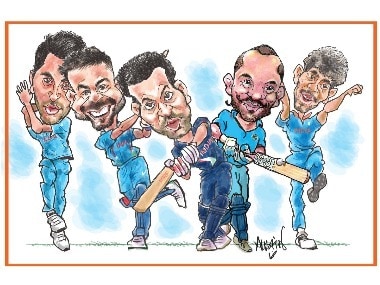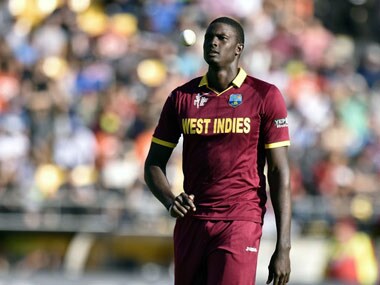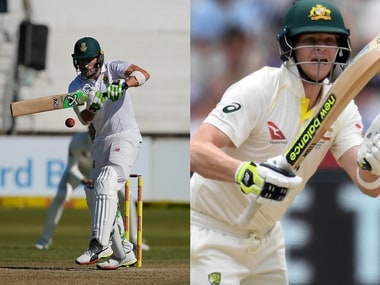Tale of two Virat Kohlis: Skewed pay structure means Indian cricket's rich get richer and poor, poorer
In India, greed at the highest echelons in cricket leaves crumbs for players at the entry level, creating a vast divide between them and the likes of Virat Kohli
Austin Coutinho, March 10, 2018
| Rank | Team | Points | Rating |
|---|---|---|---|
| 1 | India | 5313 | 121 |
| 2 | South Africa | 4484 | 115 |
| 3 | Australia | 4174 | 104 |
| 4 | New Zealand | 3489 | 100 |
| 5 | England | 4829 | 99 |
| 6 | Sri Lanka | 4374 | 95 |
| Rank | Team | Points | Rating |
|---|---|---|---|
| 1 | India | 7594 | 122 |
| 2 | South Africa | 6911 | 117 |
| 3 | New Zealand | 6782 | 116 |
| 4 | England | 7102 | 116 |
| 5 | Australia | 6376 | 112 |
| 6 | Pakistan | 4877 | 96 |
| Rank | Team | Points | Rating |
|---|---|---|---|
| 1 | Pakistan | 3272 | 126 |
| 2 | Australia | 2513 | 126 |
| 3 | India | 3940 | 119 |
| 4 | New Zealand | 3013 | 116 |
| 5 | West Indies | 2538 | 115 |
| 6 | England | 2402 | 114 |





India has one Virat Kohli who was seventh in the Forbes list of most valuable athletes in 2017. And then, there’s another ‘Virat Kohli’ who barely makes Rs 50,000 a month.
This is the reality of Indian cricket, and Indian sport in general. Kohli, thanks to the Board of Control for Cricket in India’s (BCCI) benevolence, just got richer. The other ‘Kohli’, unfortunately, for reasons outside the scope of this article, keeps getting poorer.
Kohli’s brand value last year, according to Forbes, was $14.5 million; a million more than the effervescent FC Barcelona striker, Lionel Messi. The Indian skipper — along with four other players — will now be paid an annual retainer of Rs 7 crore by the BCCI, as against the Rs 2 crore he was paid last season.
It is estimated that Kohli’s brand value in 2018-19 could be around $17.5 million.
The other batsman, popularly known as ‘Virat Kohli’ on the local tennis ball cricket circuit, lives in a dilapidated house on the outskirts of Mumbai. Talented enough to play a couple of Ranji Trophy matches, and a few one-dayers, he now has an annual player contract with a car outlet that fetches him Rs 20,000 per month.
The other Kohli, therefore, besides playing inter-company and inter-club matches — and performing well to retain the contract — works extra hours as a personal trainer to supplement his income.
In between these two Virat Kohlis is the country’s elite first-class player. Take for instance the Mumbai skipper, Aditya Tare who represents the city in all three formats of the game. Before the Supreme Court appointed Committee of Administrators (CoA) announced its grandiose new scheme for 2018-19, he was paid Rs 10,000 per day as match fee and a portion of the 26 percent of gross revenue earned by BCCI.
Tare shall now receive Rs 35,000 per day, an impressive 350 percent increase on the face of it. But therein lies the catch! He shall not be paid a share of BCCI’s gross income. Therefore, he stands to gain a maximum of Rs 1 lakh per season overall; nothing more. Peanuts, as compared to Kohli!
The chasm between the haves and have-nots of Indian cricket is widening. Illustration courtesy Austin Coutinho
Compare this with England and Australia, where cricketers can expect to make a fairly decent living playing and coaching at the club level. Unlike in India, where greed at the highest echelons in cricket leaves crumbs for players at the entry level, there is more equitable distribution of wealth in other places and in other sports.
Cricket in India is now like its film industry. A Salman Khan or an Akshay Kumar can demand millions for a lead role, akin to Kohli and Rohit Sharma, while the others can go scrounge. A+ Grade players can lead a five-star life style, while an ordinary player, who often plays in the same team as the superstars, can only munch a 5-star chocolate for lunch.
The new annual contracts announced recently by the CoA, on the face of it, look highly discriminatory. While one can understand the value that Kohli, Bhuvneshwar Kumar and Jasprit Bumrah bring to the Indian team, in all formats of the game, can the same be said about Rohit Sharma and Shikhar Dhawan? The CoA believes that these two players walk into India’s Test, ODI and T20 sides and therefore they are placed in the A+ category.
Is there something that more than meets the eye in these selections?
The A, B and C category annual contracts are worth Rs 5 crore, Rs 3 crore and Rs 1 crore respectively. Can somebody explain to me how, and on what criteria, are KL Rahul, Umesh Yadav, Ishant Sharma and Dinesh Karthik (B grade) better than Kedar Jadhav, Manish Pandey or Axar Patel (C Grade)?
Or can someone tell me how a Karun Nair, a Parthiv Patel and a Jayant Yadav get into the lists ahead of a Shardul Thakur, a Rishabh Pant and a Washington Sunder — who haven’t been offered contracts?
That the mighty and powerful (including some players) have been ruling Indian cricket for many, many decades is no secret. That it goes on despite the Supreme Court’s intervention is astonishing. Dilip Vengsarkar’s revelation, at a recent function, that he was sacked as the chairman of selectors because he chose Kohli ahead of S Badrinath should open many eyes.
BCCI’s eyes have mercifully been open to the financial and medical problems that players of the past have faced, though. Cricketers these days earn millions overnight, while some from earlier eras are struggling to make both ends meet.
Monthly pensions are now distributed to ex-Ranji and Test players. It is, however, surprising to know that widows of Test players and Test umpires receive their husband’s pensions but the same facility hasn’t been extended to the widows of former Ranji Trophy players. If true, this is an anomaly that BCCI needs to correct right away!
Yeshwant ‘Baba’ Sidhaye was a deaf and mute all-rounder who played first-class cricket for Bombay, Maharashtra and the Railways. He played 51 matches between 1952 and 1968. Later a highly respected coach, it is said that the Bollywood movie Iqbal was inspired by Baba’s life.
“It is so unfair,” says Baba Sidhaye’s son, Pravin, who himself was a good club cricketer. “Despite my father’s selfless service to the game and his reputation as a very good first-class batsman and brilliant fielder, the BCCI has refused to recognise his feats.”
“What’s more,” says Pravin, “my 83-year-old mother has had to fend for herself. She hasn’t been paid any pension by the board.”
BCCI surely needs to be a little more empathetic with former players and their families. .
And it certainly needs to be more empathetic in helping domestic cricket get back onto the road of progress. Cricket isn’t only about international matches and the IPL. State associations are fast becoming dysfunctional, systems are falling apart and the game, at the grassroots level, is on its last legs. Politicians need to go, urgently, and have to be replaced by professional managers and ex-cricketers at the earliest. Cricket administration has to be more vibrant again.
It is only when a professionally managed board takes over Indian cricket that the cavernous gap between the two Virat Kohlis can fill up. The earlier the better!
The author is a caricaturist and sportswriter. A former fast bowler and coach, he is now a sought after mental toughness trainer.
Published Date:March 10, 2018
| Updated Date: March 10, 2018
Also See
ICC World Cup 2019: Who has booked his place on Team India — and who hasn’t?
IPL 2018: BCCI gives thumbs-up to DRS for the upcoming edition of tournament
Overwhelming IPL can seriously harm women's cricket; holding simultaneous matches not advisable